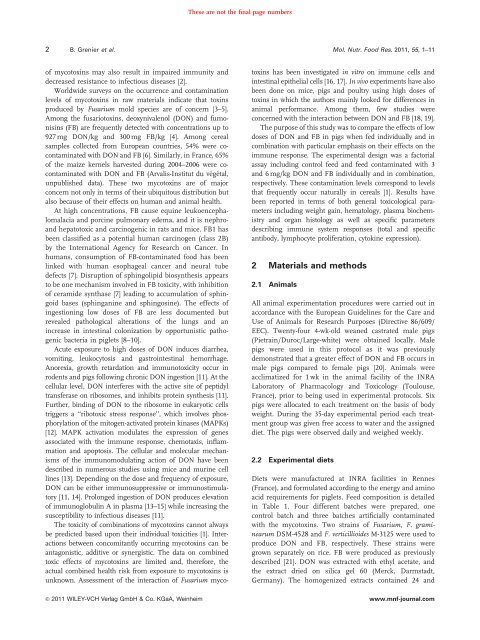Effet chez le porcelet d'une exposition à un régime co-contaminé en ...
Effet chez le porcelet d'une exposition à un régime co-contaminé en ...
Effet chez le porcelet d'une exposition à un régime co-contaminé en ...
You also want an ePaper? Increase the reach of your titles
YUMPU automatically turns print PDFs into web optimized ePapers that Google loves.
These are not the final page numbers2 B. Gr<strong>en</strong>ier et al. Mol. Nutr. Food Res. 2011, 55, 1–11& 2011 WILEY-VCH Verlag GmbH & Co. KGaA, Weinheimof my<strong>co</strong>toxins may also result in impaired imm<strong>un</strong>ity anddecreased resistance to infectious diseases [2].Worldwide surveys on the occurr<strong>en</strong>ce and <strong>co</strong>ntamination<strong>le</strong>vels of my<strong>co</strong>toxins in raw materials indicate that toxinsproduced by Fusarium mold species are of <strong>co</strong>ncern [3–5].Among the fusariotoxins, deoxyniva<strong>le</strong>nol (DON) and fumonisins(FB) are frequ<strong>en</strong>tly detected with <strong>co</strong>nc<strong>en</strong>trations up to927 mg DON/kg and 300 mg FB/kg [4]. Among cerealsamp<strong>le</strong>s <strong>co</strong>l<strong>le</strong>cted from European <strong>co</strong><strong>un</strong>tries, 54% were <strong>co</strong><strong>co</strong>ntaminatedwith DON and FB [6]. Similarly, in France, 65%of the maize kernels harvested during 2004–2006 were <strong>co</strong><strong>co</strong>ntaminatedwith DON and FB (Arvalis-Institut du végétal,<strong>un</strong>published data). These two my<strong>co</strong>toxins are of major<strong>co</strong>ncern not only in terms of their ubiquitous distribution butalso because of their effects on human and animal health.At high <strong>co</strong>nc<strong>en</strong>trations, FB cause equine <strong>le</strong>uko<strong>en</strong>cephalomalaciaand porcine pulmonary edema, and it is nephroandhepatotoxic and carcinog<strong>en</strong>ic in rats and mice. FB1 hasbe<strong>en</strong> classified as a pot<strong>en</strong>tial human carcinog<strong>en</strong> (class 2B)by the International Ag<strong>en</strong>cy for Research on Cancer. Inhumans, <strong>co</strong>nsumption of FB-<strong>co</strong>ntaminated food has be<strong>en</strong>linked with human esophageal cancer and neural tubedefects [7]. Disruption of sphingolipid biosynthesis appearsto be one mechanism involved in FB toxicity, with inhibitionof ceramide synthase [7] <strong>le</strong>ading to accumulation of sphingoidbases (sphinganine and sphingosine). The effects ofingestioning low doses of FB are <strong>le</strong>ss docum<strong>en</strong>ted butrevea<strong>le</strong>d pathological alterations of the l<strong>un</strong>gs and anincrease in intestinal <strong>co</strong>lonization by opport<strong>un</strong>istic pathog<strong>en</strong>icbacteria in pig<strong>le</strong>ts [8–10].Acute exposure to high doses of DON induces diarrhea,vomiting, <strong>le</strong>ukocytosis and gastrointestinal hemorrhage.Anorexia, growth retardation and imm<strong>un</strong>otoxicity occur inrod<strong>en</strong>ts and pigs following chronic DON ingestion [11]. At thecellular <strong>le</strong>vel, DON interferes with the active site of peptidyltransferase on ribosomes, and inhibits protein synthesis [11].Further, binding of DON to the ribosome in eukaryotic cellstriggers a ‘‘ribotoxic stress response’’, which involves phosphorylationof the mitog<strong>en</strong>-activated protein kinases (MAPKs)[12]. MAPK activation modulates the expression of g<strong>en</strong>esassociated with the imm<strong>un</strong>e response, chemotaxis, inflammationand apoptosis. The cellular and mo<strong>le</strong>cular mechanismsof the imm<strong>un</strong>omodulating action of DON have be<strong>en</strong>described in numerous studies using mice and murine celllines [13]. Dep<strong>en</strong>ding on the dose and frequ<strong>en</strong>cy of exposure,DON can be either imm<strong>un</strong>osuppressive or imm<strong>un</strong>ostimulatory[11, 14]. Prolonged ingestion of DON produces e<strong>le</strong>vationof imm<strong>un</strong>oglobulin A in plasma [13–15] whi<strong>le</strong> increasing thesusceptibility to infectious diseases [11].The toxicity of <strong>co</strong>mbinations of my<strong>co</strong>toxins cannot alwaysbe predicted based upon their individual toxicities [1]. Interactionsbetwe<strong>en</strong> <strong>co</strong>n<strong>co</strong>mitantly occurring my<strong>co</strong>toxins can beantagonistic, additive or synergistic. The data on <strong>co</strong>mbinedtoxic effects of my<strong>co</strong>toxins are limited and, therefore, theactual <strong>co</strong>mbined health risk from exposure to my<strong>co</strong>toxins is<strong>un</strong>known. Assessm<strong>en</strong>t of the interaction of Fusarium my<strong>co</strong>toxinshas be<strong>en</strong> investigated in vitro on imm<strong>un</strong>e cells andintestinal epithelial cells [16, 17]. In vivo experim<strong>en</strong>ts have alsobe<strong>en</strong> done on mice, pigs and poultry using high doses oftoxins in which the authors mainly looked for differ<strong>en</strong>ces inanimal performance. Among them, few studies were<strong>co</strong>ncerned with the interaction betwe<strong>en</strong> DON and FB [18, 19].The purpose of this study was to <strong>co</strong>mpare the effects of lowdoses of DON and FB in pigs wh<strong>en</strong> fed individually and in<strong>co</strong>mbination with particular emphasis on their effects on theimm<strong>un</strong>e response. The experim<strong>en</strong>tal design was a factorialassay including <strong>co</strong>ntrol feed and feed <strong>co</strong>ntaminated with 3and 6 mg/kg DON and FB individually and in <strong>co</strong>mbination,respectively. These <strong>co</strong>ntamination <strong>le</strong>vels <strong>co</strong>rrespond to <strong>le</strong>velsthat frequ<strong>en</strong>tly occur naturally in cereals [1]. Results havebe<strong>en</strong> reported in terms of both g<strong>en</strong>eral toxi<strong>co</strong>logical parametersincluding weight gain, hematology, plasma biochemistryand organ histology as well as specific parametersdescribing imm<strong>un</strong>e system responses (total and specificantibody, lymphocyte proliferation, cytokine expression).2 Materials and methods2.1 AnimalsAll animal experim<strong>en</strong>tation procedures were carried out inac<strong>co</strong>rdance with the European Guidelines for the Care andUse of Animals for Research Purposes (Directive 86/609/EEC). Tw<strong>en</strong>ty-four 4-wk-old weaned castrated ma<strong>le</strong> pigs(Pietrain/Duroc/Large-white) were obtained locally. Ma<strong>le</strong>pigs were used in this proto<strong>co</strong>l as it was previouslydemonstrated that a greater effect of DON and FB occurs inma<strong>le</strong> pigs <strong>co</strong>mpared to fema<strong>le</strong> pigs [20]. Animals wereacclimatized for 1 wk in the animal facility of the INRALaboratory of Pharma<strong>co</strong>logy and Toxi<strong>co</strong>logy (Toulouse,France), prior to being used in experim<strong>en</strong>tal proto<strong>co</strong>ls. Sixpigs were allocated to each treatm<strong>en</strong>t on the basis of bodyweight. During the 35-day experim<strong>en</strong>tal period each treatm<strong>en</strong>tgroup was giv<strong>en</strong> free access to water and the assigneddiet. The pigs were observed daily and weighed weekly.2.2 Experim<strong>en</strong>tal dietsDiets were manufactured at INRA facilities in R<strong>en</strong>nes(France), and formulated ac<strong>co</strong>rding to the <strong>en</strong>ergy and aminoacid requirem<strong>en</strong>ts for pig<strong>le</strong>ts. Feed <strong>co</strong>mposition is detai<strong>le</strong>din Tab<strong>le</strong> 1. Four differ<strong>en</strong>t batches were prepared, one<strong>co</strong>ntrol batch and three batches artificially <strong>co</strong>ntaminatedwith the my<strong>co</strong>toxins. Two strains of Fusarium, F. graminearumDSM-4528 and F. verticillioides M-3125 were used toproduce DON and FB, respectively. These strains weregrown separately on rice. FB were produced as previouslydescribed [21]. DON was extracted with ethyl acetate, andthe extract dried on silica gel 60 (Merck, Darmstadt,Germany). The homog<strong>en</strong>ized extracts <strong>co</strong>ntained 24 andwww.mnf-journal.<strong>co</strong>m

















